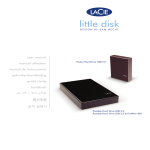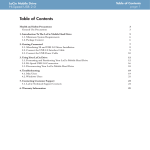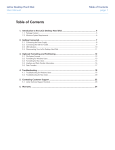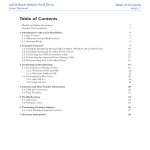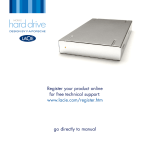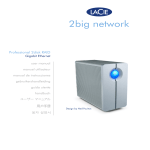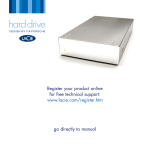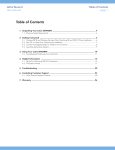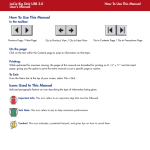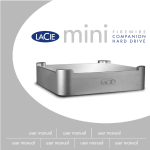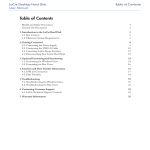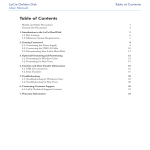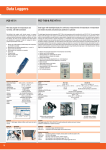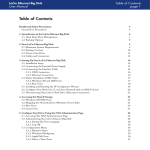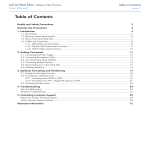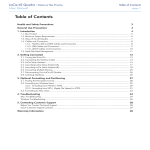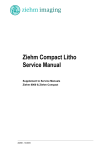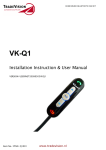Download USB Key User Manual
Transcript
Table of Contents Table of Contents Health and Safety Precautions General Use Precautions 3 3 1. Introduction To The LaCie USB Key 1.1. Package Content 1.2. Minimum System Requirements 5 6 6 2. Getting Connected 2.1. Silverlining 98 and USB 2.0 Driver Installation 2.2. Silverlining Pro Installation 2.3. Connect the Integrated USB 2.0 Interface Cable 2.4. Disconnect Your LaCie USB Key 7 7 8 9 10 3. Helpful Information 3.1. Formatting and Partitioning Your LaCie USB Key 3.2. Hi-Speed USB 2.0 Connection 3.3. Data Transfers 11 12 15 16 4. Troubleshooting 4.1. Mac Users 4.2. Windows Users 17 17 19 5. Contacting Customer Support 5.1. LaCie Technical Support Contacts 21 22 6. Warranty Information 23 user manual | Forward Copyrights Copyright © 2006 LaCie. All rights reserved. No part of this publication may be reproduced, stored in a retrieval system, or transmitted in any form or by any means, electronic, mechanical, photocopying, recording or otherwise, without the prior written consent of LaCie. Trademarks Apple, Mac, and Macintosh are registered trademarks of Apple Computer, Inc. Microsoft, Windows 98, Windows 98 SE, Windows 2000, Windows Millennium Edition and Windows XP are registered trademarks of Microsoft Corporation. Other trademarks mentioned in this manual are the property of their respective owners. Changes The material in this document is for information only and subject to change without notice. While reasonable efforts have been made in the preparation of this document to assure its accuracy, LaCie assumes no liability resulting from errors or omissions in this document, or from the use of the information contained herein. LaCie reserves the right to make changes or revisions in the product design or the product manual without reservation and without obligation to notify any person of such revisions and changes. Canada Compliance Statement LaCie USB Key Tested To Comply With FCC standards For Home of Office Use This Class A digital apparatus meets all requirements of the Canadian Interference-Causing Equipment Regulations. FCC Statement This device complies with Part 15 of the FCC Rules. Operation is subject to the following conditions: 1. The devices may not cause harmful interference 2. The devices must accept any interference received, including interference that may cause undesired operation. NOTE: This equipment has been tested and found to comply with the limits for a Class B digital device, pursuant to Part 15 of the FCC Rules. These limits are designed to provide reasonable protection against harmful interference in a residential installation. This equipment generates, uses and can radiate radio frequency energy and, if not installed and used in accordance with the instructions, may cause harmful interference to radio communications. However, there is no guarantee that interference will not occur in a particular installation. If this equipment does cause harmful inter- ference to radio or television reception, which can be determined by turning the equipment off and on, the user is encouraged to try and correct the interference by one or more of the following measures: • Reorient or relocate the receiving antenna. • Increase the separation between the equipment and receiver. • Connect the equipment into an outlet on a circuit different from that to which the receiver is connected. • Consult the dealer or an experienced radio/TV technician for help. Modifications to this product not authorized by LaCie could void the FCC & Industry Canada regulations and negate your authority to operate the product. CAUTION: Modifications not authorized by the manufacturer may void the user’s authority to operate this device. Manufacturer’s Declaration for CE Certification We, LaCie, solemnly declare that this product conforms to the following European standards: Class B EN60950, EN55022, EN55024 With reference to the following conditions: 73/23/EEC Low Voltage Directive; 89/336/EEC EMC Directive user manual | Forward This symbol on the product or on its packaging indicates that this product must not be disposed of with your other household waste. Instead, it is your responsibility to dispose of your waste equipment by handing it over to a designed collection point for the recycling of waste electrical and electronic equipment. The separate collection and recycling of your waste equipment at the time of disposal will help to conserve natural resources and ensure that it is recycled in a manner that protects human health and the environment. For more information about where you can drop off your waste equipment for recycling, please contact your local city office, your household waste disposal service, or the shop where you purchased the product. CAUTION: The Drive's warranty may be void as a result of the failure to respect the precautions listed above. Health and Safety Precautions • Only qualified persons are authorized to carry out maintenance on this device. • Read this User Manual carefully and follow the correct procedure when setting up the device. • Do not open your drive or attempt to disassemble or modify it. Never insert any metallic object into the drive to avoid any risk of electrical shock, fire, short-circuiting or dan- gerous emissions. Your drive contains no user-serviceable parts. If it appears to be malfunctioning, have it inspected by a qualified LaCie Technical Support representative. • Never expose your device to rain, or use it near water, or in damp or wet conditions. Never place objects containing liquids on the drive, as they may spill into its openings. Doing so increases the risk of electrical shock, short-cir- cuiting, fire or personal injury. • Make sure that the computer and drive are electrically grounded. If the devices are not grounded, there is an increased risk of electrical shock. Power requirements 100240 V~, 1.5 A, 60-50 Hz, (Supply voltage fluctuations not exceeding ± 10% of the nominal, transient overvoltages according to over-voltage category II). General Use Precautions • Do not expose the drive to temperatures outside the range of 5° C to 35° C (41° F to 95° F); or to operational humidity beyond 5-80%, non-condensing, or non-operating humidity beyond 10-90%, non-condensing. Doing so may damage the drive or disfigure its casing. Avoid placing your drive near a source of heat or exposing it to sunlight (even through a window). Inversely, placing your drive in an environment that is too cold or humid may damage the unit. • Always unplug the drive from the electrical outlet if there is a risk of lightning or if it will be unused for an extended period of time. Otherwise, there is an increased risk of electrical shock, short-circuiting or fire. • Do not use the drive near other electrical appliances such as televisions or radios. Doing so may cause interference which will adversely affect the operation of the other products. user manual | Forward • Do not place the drive near sources of magnetic interference, such as computer displays, televisions or speakers. Magnetic interference can affect the operation and stability of your drive. • Do not place heavy objects on top of the drive or use excessive force on it. • Never use excessive force on your drive. If you detect a problem, see the Troubleshooting section in this manual. CAUTION: A shielded-type power cord is required in order to meet FCC emission limits and also to prevent interference to the nearby radio and television reception. It is essential that only the supplied power cord be used. Important Info: Any loss, corruption or destruction of data while using a LaCie drive is the sole responsibility of the user, and under no circumstances will LaCie be held liable for the recovery or restoration of this data. To help prevent the loss of your data, LaCie highly recommends that you keep TWO copies of your data; one copy on your external hard drive, for instance, and a second copy either on your internal hard drive, another external hard drive or some other form of removable storage media. LaCie offers a complete line of CD and DVD drives. If you would like more information on backup, please refer to our website. user manual | Introduction to the LaCie USB Key 1. Introduction To The LaCie USB Key Thank you for purchasing the LaCie USB Key. As small as a credit card and easy-to-use, the new LaCie USB Key is our smallest storage device ever (at a better price per GB than flash keys). With a plug & play Hi-Speed USB 2.0 connection, it can be used anywhere without the need for a cable, power-supply or drivers*. The optional extension cable is a convenient way to access computers that require a longer cable. Its compact, durable metal design stylishly supports its ultrathin 6mm (.23”) width. Store thousands of office files, photos, or songs - and even hours of video - or transfer them from computer to computer thanks to the newfound freedom and ultra-mobility that only the LaCie USB Key allows. ■ Your LaCie USB Key Capabilities • Portable: bus-powered, convenient, driver-free* • Store and back up music, photos, videos & files • Transfer files between computers * No driver needed for Windows 2000, Windows XP and Mac OS X user manual | Introduction to the LaCie USB Key 1.1. Package Content Your LaCie USB Key should contain the following: 1 LaCie USB Key with integrated HiSpeed USB 2.0 cable 2 USB extension cable 1 2 Important Info: Please save your packaging. In the event that the drive should need to be repaired or serviced, it must be returned in its original packaging. 1.2. Minimum System Requirements ■ Windows Users • Intel Pentium II 350MHz-compatible processor or greater • 32MB RAM or greater • Windows 98 SE, Windows 2000, Windows Me and Windows XP ■ Mac Users Important Info: The LaCie USB Key is compatible with the Intel Core processors. Technical note: To achieve USB 2.0 speeds, your drive must be connected to a USB 2.0 host port. If it is connected to a USB 1.1 port, your drive will operate at USB 1.1 speeds. For more details, see page 15, Hi-Speed USB 2.0 Connection. • G3 or better • 32MB RAM or greater • Mac OS 9.x (Apple USB support 1.3.5 and greater) and Mac OS X user manual | Getting Connected 2. Getting Connected Windows 98 SE and Windows ME Users Only Step 1 2.1. Silverlining 98 and USB 2.0 Driver Installation Page 7 Step 2 2.3. Connect the Integraded USB 2.0 Cable Page 9 Mac OS 9.x Users Only Step 1 2.2. Silverlining Pro Installation Page 8 Step 2 2.3. Connect the Integraded USB 2.0 Cable Page 9 Other Users Step 1 2.3. Connect the Integraded USB 2.0 Cable Once you’ve followed these steps and the drive has mounted on your computer, move on to page 11, Page 9 Helpful Information, for important information on how to format and use your drive. 2.1. Silverlining 98 and USB 2.0 Driver Installation Important Info: This step is necessary ONLY for Windows 98 SE and Windows ME users. See page 7 for installation steps necessary for your operating system. To use your new LaCie USB Key, first download and install the necessary driver software and Silverlining 98 from the LaCie website. Follow the steps below to install the necessary drivers and software to configure your drive. Then move on to the integrated USB cable connection steps on page 9. Step 1: USB 2.0 Driver Installation 1. Download USB 2.0 drivers from www.lacie.com/support/drivers/. 2. Unzip the downloaded file. 3. Double click on the installer icon and follow the steps to install the drivers. Step 2: Silverlining 98 Installation 1. Download Silverlining 98 from www.lacie.com/support/drivers/. 2. Unzip the downloaded file. 3. Double click the installer icon and follow the steps to install Silverlining 98. Once you see a dialog window that verifies successful installation, you can move on to page 9. user manual | Getting Connected 2.2. Silverlining Pro Installation Important Info: This step is necessary ONLY for Mac OS 9.x users. See page 7 for installation steps necessary for your operating system. Before connecting your drive, you will need to install Silverlining Pro, which will allow you to manage your drive. Follow the steps below to install the necessary software to configure your drive. Then move on to the integrated USB cable connection steps on page 9. Silverlining Pro Installation 1. Download Silverlining Pro from www.lacie.com/support/drivers/. 2. Unzip the downloaded file. 3. Double click the installer icon and follow the steps to install Silverlining Pro. Once you see a dialog window that verifies successful installation, you can move on to page 9. user manual | Getting Connected 2.3. Connect the Integrated USB 2.0 Interface Cable 1. Unfold and connect the integrated Hi-Speed USB 2.0 cable to your computer. After a few seconds, your LaCie drive will mount on your computer. You also may use the included USB extension cable by connecting the integrated USB 2.0 cable to it and then connecting the extension cable to your computer. 1 Technical note: To achieve Hi-Speed USB 2.0 transfer rates, you have to be connected to a Hi-Speed USB 2.0 port on your computer. Otherwise, you will be limited to USB 1.1 data transfer rates. Technical note: For more information on USB connections, see page 15, Hi-Speed USB 2.0 Connection. Technical note: The LaCie USB Key is plug & play for Windows 2000, Windows XP and Mac OS X. Windows 98SE and Windows Me users should install the included driver software and Silverlining 98. Mac OS 9.x users should install Silverlining Pro software. user manual | Getting Connected 2.4. Disconnect Your LaCie USB Key USB external devices feature “plug & play” connectivity, which means that your drive can be connected and disconnected while the computer is running. To prevent failures, however, it is important you follow these steps when disconnecting your LaCie USB Key. ■ Windows Users ■ Mac Users 1. From the System Tray (located in the lower right-hand side of your screen), click the Eject icon (a small green arrow over a hardware image). 1. Drag the hard drive icon to the trash. 2. The drive can now be disconnected. 2. A message will appear, detailing the devices that the Eject icon controls, i.e. “Safely remove...”. Click on this prompt. 3. You will be then given this message: “Safe to Remove Hardware” (or similar). It is now safe to disconnect the device. user manual | 10 Helpful Information 3. Helpful Information Once you’ve connected your drive and it is recognized by your operating system (i.e. Windows 98 SE, Me, 2000, XP or Mac OS 9.x or 10.x), you are ready to format and partition the drive. In order to store information on a hard drive, it must have a file system and be divided into sections that will contain the data that you wish to store. This process is called formatting. In order to utilize a hard disk drive, it has to be formatted first. Formatting a disk consists of the following: the operating system erases all of the bookkeeping information on the disk, tests the disk to make sure that all of the sectors are reliable, marks bad sectors (i.e., those that are scratched) and creates internal address tables that it later uses to locate information. Once formatted, the actual available storage capacity varies, depending on operating environment, and is gen- erally about 10% less than the non-formatted capacity. After you’ve formatted the drive, you will the opportunity to divide the hard drive into sections, called Partitioning. A partition is a section of the hard drive’s storage capacity that is created to contain files and data. For instance, you could create three partitions on your drive: one partition for your word documents, one for your spreadsheets and one for your multi-media files. Technical note: FAT 32 is recommended for sharing a hard drive with Windows 98 SE and Mac OS users. However keep in mind that the FAT 32 format will slow down your hard drive and single file size is limited to 4 GB. Use NTFS if... Use HFS+ if... ...you will be using the drive only under Windows 2000 or Windows XP (performance will generally be greater when compared to FAT 32). This file system is compatible in read only mode with Mac OS 10.3 and higher. ...you will be using the drive on Macs only; performance will generally be greater when compared to FAT 32. This file system is NOT compatible with Windows OS. Use FAT 32 if... For more information, please refer to page 12, Formatting And Partitioning Your LaCie USB Key. ...you will be using your drive between both Windows and Mac OS 9.x or 10.x; or sharing the drive between Windows 2000, XP, and 98 SE. Maximum single file size: 4GB. user manual | 11 Helpful Information 3.1. Formatting and Partitioning Your LaCie USB Key Once you have set-up your LaCie USB Key, you can reformat or partition it to suit your needs. ■ Windows Users Windows 98 SE and Me users must install and use LaCie Silverlining 98, which is available for download from the LaCie website (see page 7 for details). Windows 2000 and XP users will use the Disk Management Utility application, which is native to the Windows operating system. Formatting And Partitioning Using Disk Management Utility The process of formatting a drive on a computer running Windows 2000 or Windows XP consists of two steps: (1) installing a signature on the drive, and (2) formatting the drive. These steps will erase anything that is on the disk. 1. Connect the drive to the computer via the interface port. 2. Right click My Computer and click Manage. 3. From the Computer Management window, select Disk Management (located below the Storage group). 4. If the Initialize and Convert Disk Wizard window appears, click Cancel. 5. Windows will list the hard drives that are installed on the system. Locate the drive that is represented by the icon. Right click the icon and select Initialize. Disk management utility user manual | 12 Helpful Information 6. In the box to the right that says Unallocated, right click and select New Partition... 7. In the first page of the New Partition Wizard, click Next. 8. Click Next. 9. Click Next. 10. Click Next. 11. Click Next. Disk management utility 12. In this window, you have the option of selecting the Quick Format option. This allows a much faster format; however, this will disallow Disk Managmnet to check the drive for errors (recommended). Click Next. Disk management utility 13. Click Finish to begin the format process. 14. Your drive is ready for use and should now appear in your My Computer. Important Info: Please refer to page 11, Helpful Information, for a more detailed comparison of the various file system formats. Important Info: Following these steps will erase anything that is on the hard drive. Therefore, if you have information that you want to protect or continue to use, backup this information before performing these steps. Disk management utility (drive ready for use) user manual | 13 Helpful Information ■ Mac Users Mac OS 9.x users must install and use LaCie Silverlining Pro, which is available for download from the LaCie website (see page 8 for details). Mac OS 10.x users will use the Apple Disk Utility application, which is native to the Mac operating system. Important Info: Following these steps will erase anything that is on the hard drive. Therefore, if you have information that you want to protect or continue to use, backup this information before performing these steps. 1. Connect the drive to the computer via one of its interfaces and turn on the drive by pressing the blue button. 2. Go to the Menu Bar, and open Go. 3. From the Go menu, click on Applications. 4. In the Applications menu, open the Utilities folder, and then double-click Disk Utility from the Utilities folder. 5. The Disk Utility window will open. In the left side of the window will be a list of the available hard disk drives. You should see a volume that represents your internal hard drive, and one labeled LaCie Hard Drive. 6. From the Volume Scheme: button, choose the number of partitions you want to divide the drive into by clicking on the pull down menu starting with Current (Mac OS 10.x gives you the option of dividing the drive into at most 8 partitions). You can customize the size of the partitions by using the slide bar between the partitions in the Volume Scheme: area. 7. In the Volume Information section, create a name for each partition, choose the volume format (Mac OS Extended, Mac OS Standard or UNIX File System) and the volume size. Disk management utility (Mac) Important Info: Please refer to page 11, Helpful Information, for a more detailed comparison of the various file system formats. Important Info: Apple recommends that unless you have a specific reason to use the UNIX File System (UFS), you should use the Mac OS Extended format since it provides a more familiar experience to Macintosh users. 8. Once you have finalized the volume format, number of partitions, size and options, click OK. The following message will appear: Warning! Saving the new volume will erase all existing volumes. This can NOT be undone. Are you sure you want to do that? Click Partition to continue. 9. Mac OS 10.x will automatically setup the disk with the partitions and volume format you selected, and your new drive will be available for use. user manual | 14 Helpful Information 3.2. Hi-Speed USB 2.0 Connection ■ What is USB 2.0? The new USB 2.0 standard provides higher bandwidth for high-speed peripherals such as external hard drives, high-speed scanners and CD-RW drives. USB 2.0 delivers transfer rates up to 480Mb/s, while conveniently maintaining backward compatibility with USB 1.1 devices. USB 2.0 can still be used to connect lower-speed USB 1.1 ports and devices like digital cameras, scanners, modems, keyboards, mice, joysticks and printers. In the USB 2.0 system, existing USB peripherals do not have to be upgraded, and lower speed devices will not require additional performance, instead operating as USB 1.1 devices. USB 2.0 logo USB 1.1 logo ■ USB 2.0 Host Bus Adapters and Performance connected to the port to work at their correct speeds. For installation instructions, please refer to the documentation that comes with the host adapter card. LaCie supplies only the appropriate USB 2.0 drivers for its peripherals and does not provide drivers for thirdparty host adapter cards. To obtain the right drivers for your host adapter card, visit your card manufacturer’s Internet site. ■ USB Cables and Connectors Your LaCie drive is shipped with a USB 2.0-certified USB cable, to ensure maximum data transfer performance when connected to a USB 2.0 port. The cable will also work when connected to a USB 1.1 port, but drive performance will be limited to USB 1.1 transfer rates. There are also different types of USB connections, such as the mini-cable and device end. Make sure that you have the correct type of connection on computer. Consult LaCie Customer Support or your LaCie reseller for more information. To utilize the newly-enhanced USB 2.0 performances, your computer must be equipped with a USB 2.0 host bus adapter card (sold separately, such as the LaCie USB 2.0 PCI Card, or integrated by your PC manufacturer) and the appropriate drivers. These host bus adapter cards, which include one or more USB ports, are shipped with special USB 2.0 drivers that enable the computer to control the card. These drivers must be installed in order for USB 2.0 devices Hi-Speed USB 2.0 cable user manual | 15 Helpful Information 3.3. Data Transfers Data transfers are the flow of data that accomplishes a task, usually related to moving data from storage to computer RAM or between storage devices. During data transfers, it’s best to wait before launching other applications on the same USB port. Anomalies may arise with computers that have USB controllers* that do not conform to OHCI (Open Host Controller Interface) standards. In any other configurations, we cannot ensure 100% correct operation. Due to this, you may encounter hanging problems. If this happens, proceed as follows: 1. Make sure that the USB cable is connected tightly and securely on both ends of the cable, from the drive to the computer. If you are using a USB cable other than the one supplied with your LaCie drive, check that it is USB 2.0 certified. The cable that is provided with your LaCie drive is USB 2.0 certified. Technical note: *Controller - This is a component or an electronic card (referred to in this case as a “controller card”) that enables a computer to communicate with or manage certain peripherals. An external controller is an expansion card which fills one of the free slots (i.e. PCI or PCMCIA) inside your PC and which enables a peripheral (i.e. CDR/ RW drive, Hard Drive, scanner or printer) to be connected to the computer. If your computer is not equipped with a USB 2.0 controller card, you can purchase an external controller through LaCie. Contact your LaCie reseller or LaCie Technical Support (page 21, Contacting Customer Support) for more information. 2. Check that the power supply and ground connection are seated properly. 3. Disconnect your computer’s USB cable. Wait 30 seconds. Reconnect. user manual | 16 Troubleshooting 4. Troubleshooting In the event that your LaCie USB Key is not working correctly, please refer to the following checklist to find out where the problem is coming from. If you have gone through all of the points on the checklist and your drive is still not working correctly, please have a look at the FAQs that are regularly published on our website – www.lacie.com. One of these FAQs may provide an answer to your specific question. You can also visit the drivers pages, where the most recent software updates will be available. If you need further assistance, please contact your LaCie reseller or LaCie Technical Support (see page 21, Contacting Customer Support for details). ■ Manual Updates LaCie is constantly striving to give you the most up-to-date, comprehensive User Manuals available on the market. It is our goal to provide you with a friendly, easy-to-use format that will help you quickly install and utilize the many functions of your new device. If your manual does not reflect the configurations of the product that you purchased, please check our website for the most current version available. 4.1. Mac Users Problem Question Answer The drive is not recognized by the computer. Does an icon for the drive appear on the desktop? There should be an icon for the LaCie drive on the desktop. If the drive does not appear, follow the rest of the Troubleshooting tips to isolate the problem. Does your computer’s configuration meet the minimum system requirements for use with this drive? Check page 6, Minimum System Requirements for more information. Did you follow the correct installation steps for the specific interface and operating system? Review the installation steps on page 9, Connect the Integrated USB 2.0 Interface Cable. Is the integrated USB firmly connected to your computer, or are both ends of the USB extension cable firmly attached? Check both ends of the USB cables and make sure that they are fully seated in their respective ports. Try disconnecting the cables, waiting 10 seconds, and then reconnecting them. If the drive is still not recognized, restart your computer and try again. user manual | 17 Troubleshooting Problem Question Answer The drive is not recognized by the computer. Have the USB drivers been installed correctly and enabled (Windows 98 SE and Windows ME users only)? Open Apple System Profiler and click on the Devices and Volumes tab. If your device is not listed, recheck the cables and try the other troubleshooting tips listed here. Is there a conflict with other device drivers or extensions? Contact LaCie Technical Support for help. Has the drive been formatted? Make sure that the drive has been formatted properly. Please see pages 12, Formatting and Partitioning Your LaCie USB Key and 11, Helpful Information for more details. Does your computer’s operating system support the file system? Check your computer’s documentation and see pages 12, Formatting and Partitioning Your LaCie USB Bey and 11, Helpful Information for more information. Did you get an “Error –50” message while copying to a FAT 32 volume? When copying files or folders from Mac OS 10.x to a FAT 32 volume, file names with certain characters cannot be copied. These characters include, but are not limited to: ?<>/\: Check your files and folders to ensure that these types of characters are not being used. Did you get an error message telling you that the drive has been disconnected when coming out of sleep mode? Simply ignore this message. The drive will remount to the desktop. LaCie drives conserve power by spinning down when you set your computer to sleep mode, and when the computer is “woken” from sleep, it does not give the drive enough time to spin-up from its sleep mode. The drive is working slowly. Are there other USB devices connected to the same port or hub? Disconnect any other USB devices and see if the drive’s performance increases. The drive is not running noticeably faster when connected via Hi-Speed USB 2.0. Are you operating in Mac OS 9.x? Apple does not support the Hi-Speed USB 2.0 standard under Mac OS 9.x. You will be limited to the slower transfer rates of the original USB standard. Are you operating in Mac OS 10.x? Apple has only recently begun incorporating native Hi-Speed USB 2.0 ports in their computers. To achieve Hi-Speed USB 2.0 transfer rates, you will need to add a Hi-Speed USB 2.0 PCI or PC card to your computer. Is the drive connected to a USB port on your computer, or to a USB hub? If your drive is connected to a USB port or hub, this is normal. A Hi-Speed USB 2.0 device can only operate at Hi-Speed USB 2.0 performance levels when it is connected directly to a Hi-Speed USB 2.0 port or hub. Otherwise, the Hi-Speed USB 2.0 device will operate at the slower USB transfer rates. For more information, please see page 15, Hi-Speed USB 2.0 Connection. Is the drive connected to a HiSpeed USB 2.0 port on your computer? Check to see that the Hi-Speed USB 2.0 drivers for both your host bus adapter and device have been installed correctly. If in doubt, un-install the drivers and re-install them. Error messages under Mac OS 10.x. user manual | 18 Troubleshooting 4.2. Windows Users Problem Question Answer The drive is not recognized by the computer. Has the drive been formatted? Make sure that the drive has been formatted properly. Please see pages 12, Formatting and Partitioning Your LaCie USB Key and 11, Helpful Information for details. Does your computer’s operating system support the file system? Check your computer’s documentation and see pages 12, Formatting and Partitioning Your LaCie USB Key and 11, Helpful Information for details. Is there an icon for the drive in My Computer? Go into My Computer and look for an icon and drive letter assigned to the LaCie drive. If the drive does not appear, follow the rest of the Troubleshooting tips to isolate the problem. Does your computer’s configuration meet the minimum system requirements for use with this drive? Check page 6, Minimum System Requirements for more information. Did you follow the correct installation steps for the specific interface and operating system. Review the installation steps on page 9, Connect the Integrated USB 2.0 Interface Cable. Are both ends of the USB cables firmly attached? Check both ends of the USB cables and make sure that they are fully seated in their respective ports. Try disconnecting the cables, waiting 10 seconds, and then reconnecting them. If the drive is still not recognized, restart your computer and try again. Have the USB drivers been installed correctly and enabled? Windows 98 SE & Me Users: Go to Start > Settings > Control Panel > System > Device Manager > USB Controller > click on the plus sign next to the controller icon, and you should see your device listed. Windows 2000 Users: Go to Start > Settings > Control Panel > System > Hardware tab > Device Manager button > USB Controller > click on the plus sign next to the controller icon, and you should see your device listed. Windows XP Users: Go to Start > Control Panel > Performance and Maintenance > System > Hardware tab > Device Manager button > USB Controller > click on the plus sign next to the controller icon, and you should see your device listed. If you cannot see the device, recheck the cables and try the other troubleshooting solutions listed here. Is there a conflict with other device drivers or extensions? Contact LaCie Technical Support for help. user manual | 19 Troubleshooting Problem Question Answer The drive turns on and off when you turn your computer on and off. This is normal. Your drive has an autoswitching power feature, which means that if your drive is connected to your computer, turning the computer on will automatically turn the drive on. Likewise, turning the computer off will automatically turn the drive off. If you wish to power off the drive while it is connected to your computer, first make sure that your computer is not accessing the drive and then follow the steps on page 10, Disconnect Your LaCie USB Key. After you have disconnected the drive, push the blue On/Off button on the front of the drive to turn the drive off. The drive is working slowly. Are there other USB devices connected to the same port or hub? Disconnect any other USB devices and see if the drive’s performance increases. The drive is not running noticeably faster when connected via Hi-Speed USB 2.0. Is the drive connected to a USB port on your computer, or to a USB hub? If your drive is connected to a USB port or hub, this is normal. A Hi-Speed USB 2.0 device can only operate at Hi-Speed USB 2.0 performance levels when it is connected directly to a Hi-Speed USB 2.0 port or hub. Otherwise, the Hi-Speed USB 2.0 device will operate at the slower USB transfer rates. For more information, please see page 15, Hi-Speed USB 2.0 Connection. Is the drive connected to a HiSpeed USB 2.0 port on your computer? Check to see that the Hi-Speed USB 2.0 drivers for both your host bus adapter and device have been installed correctly. If in doubt, un-install the drivers and re-install them. Does your computer or operating system support Hi-Speed USB 2.0? See page 6, Minimum System Requirements. Are you using a certified Hi-Speed USB 2.0 cable to connect your drive? Ensure that the cable you are using has been properly certified. The Hi-Speed USB 2.0 cable that was shipped with your LaCie drive has been properly certified and tested to comply with USB standards. user manual | 20 Contacting Customer Support 5. Contacting Customer Support ■ Before You Contact Technical Support 1. Read the User Manual and review the Troubleshooting section. 2. Try to isolate the problem. If possible, make the drive the only external device on the CPU, and make sure that all of the cables are correctly and firmly attached. If you have asked yourself all of the pertinent questions in the troubleshooting checklist, and you still can’t get your LaCie USB Key to work properly, contact us via the contacts on page 22. Before contacting us, make sure that you are in front of your computer and that you have the following information on hand: • • • • • Your LaCie USB Key’s serial number Operating system and version Computer brand and model Amount of memory installed Names of any other devices installed on your computer, including CD/DVD burners ■ Information to Include in Email Correspondence Information Where to Find Information 1. LaCie USB Key serial number Located on a sticker at the back of drive or on the original packaging 2. LaCie USB Key file format Mac users: Select the LaCie USB Key icon on the desktop and press Command + I, or press the Control key and choose Get Info. Windows users: Right click the LaCie USB Key icon and select Properties. 3. Macintosh/PC model 4. Operating system version 5. Processor speed Mac users: Click on the Apple icon in the menu bar and select About this Mac. Windows users: Right click My Computer and select Properties > General. 6. Computer memory 7. The brands and models of other internal and external peripherals installed on my computer Mac users: Click on the Apple icon in the finder bar and select About this Mac. Select More Info... The Apple System Profiler will launch and will list your internal and external peripherals. Windows users: Right click My Computer and select Properties > Hardware. user manual | 21 Contacting Customer Support 5.1. LaCie Technical Support Contacts LaCie Asia, Singapore, and Hong Kong LaCie Australia LaCie Belgium LaCie Canada LaCie Denmark LaCie Finland LaCie France LaCie Germany LaCie Italy LaCie Japan LaCie Netherlands LaCie Norway LaCie Spain LaCie Sweden LaCie Switzerland LaCie United Kingdom LaCie Ireland LaCie USA Contact us at: http://www.lacie.com/asia/contact/ Contact us at: http://www.lacie.com/be/contact/ (Français) Contact us at: http://www.lacie.com/dk/contact Contact us at: http://www.lacie.com/fr/contact/ Contact us at: http://www.lacie.com/it/contact/ Contact us at: http://www.lacie.com/nl/contact/ Contact us at: http://www.lacie.com/es/contact/ Contact us at: http://www.lacie.com/chfr/contact/ (Français) Contact us at: http://www.lacie.com/ie/contact/ Contact us at: http://www.lacie.com/au/contact/ Contact us at: http://www.lacie.com/caen/contact/ (English) Contact us at: http://www.lacie.com/fi/contact/ Contact us at: http://www.lacie.com/de/contact/ Contact us at: http://www.lacie.com/jp/contact/ Contact us at: http://www.lacie.com/no/contact/ Contact us at: http://www.lacie.com/se/contact Contact us at: http://www.lacie.com/uk/support/request/ Contact us at: http://www.lacie.com/contact/ LaCie International Contact us at: http://www.lacie.com/intl/contact/ user manual | 22 Warranty Information 6. Warranty Information LaCie warrants your USB Key against any defect in material and workmanship, under normal use, for the period designated on your warranty certificate. In the event this product is found to be defective within the warranty period, LaCie will, at its option, repair or replace the defective USB Key. This warranty is void if: LaCie will not, under any circumstances, be liable for direct, special or consequential damages such as, but not limited to, damage or loss of property or equipment, loss of profits or revenues, cost of replacement goods, or expense or inconvenience caused by service interruptions. • The USB Key was operated/stored in abnormal use or maintenance conditions; Any loss, corruption or destruction of data while using a LaCie USB Key is the sole responsibility of the user, and under no circumstances will LaCie be held liable for the recovery or restoration of this data. • The USB Key is repaired, modified or altered, unless such repair, modification or alteration is expressly authorized in writing by LaCie; • The USB Key was subjected to abuse, neglect, lightning strike, electrical fault, improper packaging or accident; • The USB Key was installed improperly; • The serial number of the USB Key is defaced or missing; • The broken part is a replacement part such as a pickup tray, etc. • The tamper seal on the USB Key casing is broken. LaCie and its suppliers accept no liability for any loss of data during the use of this device, or for any of the problems caused as a result. Under no circumstances will any person be entitled to any sum greater than the purchase price paid for the USB Key. To obtain warranty service, call LaCie Technical Support. You will be asked to provide your LaCie product’s serial number, and you may be asked to furnish proof of purchase to confirm that the USB Key is still under warranty. All USB Keys returned to LaCie must be securely packaged in their original box and shipped with postage prepaid. Important Info: Register online for free technical support: www.lacie.com/register user manual | 23























